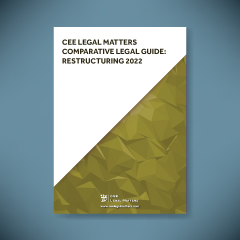Contributed by Guleryuz & Partners.
1. Overview
1.1. What domestic pieces of legislation and international instruments apply to restructuring and insolvency matters in your jurisdiction?
The main legislative and regulatory provisions that govern the Turkish restructuring and insolvency system are regulated under the Enforcement and Bankruptcy Law no. 2004 (EBL) while the Turkish Commercial Code no. 6102 and Banking Law no. 5411 contain some provisions on the matter specific to banks and financial institutions. In addition, the Law on the Procedure for the Collection of Public Receivables no. 6183 has a scope of application in insolvency matters where a public authority is a creditor. No international instruments apply in respect thereof.
1.2. Do you have a well-established legal regime governing restructuring and insolvency, or do you have rather frequent legislative changes in the area?
The legal regime is established with sporadic legislative changes.
1.3. Are there any special regimes applying to specific sectors?
No special regimes apply to specific sectors.
1.4. Were any changes to restructuring or insolvency laws adopted in response to the COVID-19 pandemic? If so, what were they?
During the COVID-19 pandemic, numerous temporary measures were introduced in Turkish law to prevent the loss of rights due to the inability to take legal actions. Under Law no. 7226, in general, the duration of litigation and the duration of certain legal proceedings, for instance, the statute of limitations and final terms, have been suspended in Turkish law. However, since all these regulations were provisional, they have been lifted with the decline in the COVID-19 pandemic. Furthermore, some amendments were introduced to the EBL in the meantime. Although there is no preamble for the amendments, the amendment regarding the introduction of e-auction sale of seized assets might be interpreted as a change in response to the COVID-19 pandemic since from now on, the sale of confiscated assets will be conducted entirely in an electronic environment.
1.5. Are there any proposed or upcoming changes to the restructuring insolvency regime in your country?
Currently, there are no proposed or upcoming changes to the restructuring insolvency regime in Turkey.
1.6. Has your country adopted or is your country considering the adoption of the UNCITRAL Model Law on Enterprise Group Insolvency?
Turkey has not adopted or, to the best of our knowledge, is not considering adopting the UNCITRAL Model Law on Enterprise Group Insolvency.
2. Insolvency
2.1. Is there an insolvency test that triggers certain obligations for directors or officers of the debtor company? If so, what is the test, and what are the consequences for failure to meet these obligations?
By law, directors or officers of the debtor company must prudentially assess whether they should file for insolvency and that they should hence not use the insolvency institution for fraudulent activities. Within this respect, if they do not file for insolvency when necessary or file for insolvency fraudulently, or intentionally reduce the assets held by debtors, a civil lawsuit may be brought against them.
In particular, a lawsuit for the annulment of the disposition, regulated in the EBL Art. 277 may be filed by the creditors against the debtors in case the debtor company malevolently tries to sell out its assets. In this respect, the creditor, who cannot collect his/her receivables through insolvency proceedings, may file the said lawsuit against the debtor and the third party who malevolently tried to sell/buy out the debtor’s properties in the last five years.
2.2. What types of insolvency procedures are established by law in your jurisdiction?
Under the EBL, insolvency proceedings can be initiated by general insolvency proceedings based on the creditor’s claim as per Art. 155-166 of the EBL; the insolvency method pertaining to commercial papers and bills as per Art. 167 and 171-176 of the EBL; or the direct insolvency method through a lawsuit as per Art. 177-178 of the EBL.
2.3. Who has the right to initiate insolvency proceedings?
Under Turkish law, both debtor and creditor are entitled to initiate insolvency proceedings depending on the type of insolvency procedure. In principle, general insolvency claims and insolvency methods pertaining to commercial papers and bills could solely be undertaken by the creditor. On the other hand, in the direct insolvency method, the creditor, the debtor, the company itself, or the liquidation administrator has the right to initiate insolvency proceedings.
2.4. What are the consequences of commencing insolvency proceedings, in particular:
2.4.1. Does management continue to operate the business, and/or is the debtor subject to supervision?
Once the insolvency proceedings are initiated, the power of disposition is transferred to the bankrupt’s estate under EBL Art. 191. Therefore, the debtor company’s representative has no authority or control over the debtor company’s receivables which are included in the bankrupt’s estate. However, in practice, the bankrupt estate usually manages the process with the unofficial involvement of the debtor company’s representative.
2.4.2. Does a moratorium or stay apply and if so, can it have an extraterritorial effect?
In Turkish law, the institution moratorium, also known as concordat, was introduced to the EBL on February 28, 2018, replacing the institution of the postponement of insolvency. Concordat is a legal institution that allows companies to restructure their debts under the supervision of the court and thus, enabling creditors to collect their receivables in a certain plan and period. In a nutshell, the preliminary project of the concordat, the comparative benefit table, the audit report giving reasonable assurance, the list showing the creditors, the amount of receivables, and the status of receivable privileges, are all documents that merchant debtors must submit to the court in order to declare a concordat. Non-merchant debtors must also submit documents outlining the status of their assets.
For the concordat to have an extraterritorial effect, a bilateral or multilateral agreement must be signed between the country of enforcement and Turkey. Yet currently, such an agreement regarding concordat with any country does not exist. In principle, creditors residing in foreign countries can claim their receivables according to the terms of the concordat. Still, they are legally not obliged to recognize the concordat or its terms and conditions.
2.4.3. How does it impact the existing contracts (e.g., is the counter-party free to terminate them, can the debtor’s pre-insolvency transactions be challenged)?
Depending on the type of the contract, the contractual relationship may terminate or not. At first, some particular kinds of contracts terminate ex officio in case of insolvency, including attorney agreements, insurance contracts, etc. On the other hand, certain contracts which are not explicitly stated in the applicable laws will still be in effect, e.g., sales contracts, ordinary lease contracts, and bailment contracts. Depending on the performance stage of a contract, different legal results may arise for such contracts. For instance, if the purchase price has been fully paid at the time of the debtor’s insolvency, whereas the goods have not yet been delivered, the creditor may request the cost of the goods from the insolvency office as an insolvency claim. Another scenario is that, in the case of insolvency, since the debtor’s power of disposal is completely transferred to the bankrupt’s estate, the estate may become a party to the said contract and may decide to deliver the goods directly to the creditor. Nevertheless, within the framework of freedom of contract, insolvency proceedings could always be incorporated into the terms of a contract as grounds for termination.
2.5. Which steps do insolvency proceedings normally include and what are the roles of the courts and other key stakeholders (such as debtor, directors of the debtor, shareholders of the debtor, secured creditors, unsecured creditors, etc.)?
The general insolvency proceeding, based on the creditor’s claim and the insolvency method pertaining to commercial papers and bills are similar in several aspects. In both procedures, the creditor first applies to the enforcement office and files an insolvency proceeding against the debtor, accordingly, the enforcement office sends an insolvency payment order to the debtor. The only difference is the nature of the document on which the creditor bases their receivables: while no documentation is required in the general insolvency method, commercial papers and bills are needed for the latter.
On the other hand, in the direct insolvency method, it is not essential for the creditor to file an insolvency claim or to send a payment order against the debtor. If one of the legal reasons specified under EBL Art. 177 is present [e.g., in case the debtor’s place of residence is unknown], the creditor, debtor, company itself, or liquidation administrator may immediately apply to the commercial court and ask for the debtor’s insolvency. Typical roles for all insolvency proceedings can be listed as follows:
- The debtor: Once the proceeding is initiated, the debtor has no power of disposition over receivables included in the bankrupt’s estate until the completion of the insolvency proceedings.
- The directors of the debtor: The directors of the debtor company whose insolvency is requested are no longer permitted to act or dispose of any assets.
- The shareholders of the debtor: In case a shareholder is also a member of the board in a joint-stock company, such a shareholder has to return the money which they have taken under the title of dividend share or another title in return for the services to the creditors of the company within last three years before the opening of the insolvency lawsuit.
- The secured creditors: According to EBL Art. 195, debts of the insolvent become due with filing an insolvency lawsuit except for receivables secured by the pledge of an immovable.
- The unsecured creditors: The claims of unsecured creditors must be registered in the record of claims during the bankruptcy proceedings.
- The insolvency administrator: The insolvency officeholder mainly sells the pledged goods and reimburses the creditor according to EBL Art. 185. Also, they have the right to file an action of nullity according to Art. 187, regulate the record of claims and determine the order in which claims are to be satisfied according to Art. 226.
- The court: When an insolvency request is made, the court might initially take any precautionary actions that it considers necessary to protect the creditors’ interests. The court also will render the insolvency and closing decision. The court has hence an exclusive authority upon the insolvency process.
2.6. In insolvency proceedings, do specific stakeholders’ claims enjoy priority (e.g., employees, pension liabilities)? Can the claims of any class of creditor be subordinated (e.g., equitable subordination)?
According to EBL articles 206 and 207, specific stakeholders’ claims are prioritized during insolvency proceedings as pledged receivables, public receivables, privileged receivables, and non-privileged receivables. However, privileged receivables, which are in third place, are also ranked among each other. In this respect, the order of the privileged receivables are as follows: employees’ receivables, all kinds of alimony receivables arising from family law that must be paid in cash, receivables of persons whose property has been left to the administration of the bankrupt due to guardianship, and receivables specified as privileged in related laws. The creditor may file an objection lawsuit against both the creditor and the insolvency administration within 15 days of the announcement of the list of creditors, according to EBL Art. 235.
2.7. What is a timeline for insolvency proceedings and how are they finalized?
Although it varies depending on each company’s financial situation, insolvency proceedings could take years. Completing the entire insolvency process results in liquidating the debtor’s assets and issuing a certificate of insolvency if the creditors are not fully satisfied, and this, in practice, is often a time-consuming process.
2.8. Are there any liabilities that survive the insolvency proceedings?
In principle, there won’t be a post-liability for the debtor after the decision of insolvency, except for incomplete debts. In this respect, a certificate of insolvency (aciz vesikasi) shall be issued for the creditors who are not fully satisfied after the liquidation process. Accordingly, with the certificate of insolvency, the creditor may be able to pursue new proceedings against the debtor if the debtor acquires new assets according to EBL Art. 251.
3. Restructuring
3.1. What formal and informal restructuring proceedings are available in your country?
Under Turkish law, there are three formal restructuring proceedings. The first one is the restructuring of corporations and cooperatives via reconciliation regulated under EBL Art. 309/m (sermaye sirketleri ve kooperatiflerin uzlasma yoluyla yeniden yapilandirilmasi). This restructuring proceeding is the legal institution that allows corporations and cooperatives to continue their activities by reconciling with their creditors and adapting their debts and, if necessary, their management organizations to new conditions. The second is the concordat regulated under EBL Art. 285, in which the debtor and the creditor agree and promise to pay the debtor’s debts on a specific schedule. The third and the last one is financial restructuring, regulated under the provisional Art. 32 of the Banking Law, enabling the debtors who have credit relations with banks, financial leasing companies, factoring companies, or financing companies operating in Turkey to fulfill their repayment obligations as per the measures to be taken within the scope of the framework agreement regarding their loan debts to these institutions (finansal yeniden yapilandirma). Alternatively, the parties may also agree through a deal within the freedom of contract, under the law of obligations, that the debtor will pay its debts by a specific plan and term.
3.2. What are the entry requirements to restructuring and how are restructuring plans approved and implemented?
a. Restructuring of Corporations and Cooperatives via Reconciliation
This restructuring proceeding is regulated between the EBL Art. 309/m-309/u and the Regulation on Restructuring of Corporations and Cooperatives via Reconciliation (Restructuring Regulation). The first prerequisite is that the company that seeks to benefit from this must be a stock corporation (sermaye sirketi) or cooperative (kooperatif. Secondly, a restructuring project must be submitted, and this project should include, inter alia, the conditions under which the debts will be satisfied, how financial instruments will be obtained to ensure this payment, and what changes will be made in the business. While preparing this restructuring project, the debtor company may undertake to pay some of its debts at previously agreed terms without making any amendments according to EBL Art. 309/m-u. Therefore, unlike the concordat, the debtor can divide the creditors into different groups and make separate offers to each group. However, all other creditors should review and approve each payment offer. Thus, the debtor invites the creditors who will be affected by the project to the negotiation meeting by registered letter with return receipt, and these creditors vote on the restructuring project according to Art. 10 of the Restructuring Regulation. In this context, the debtor is obliged to provide the necessary information and documents to the creditors who will be affected by the project. Afterward, in the event that creditors accept the reconstruction project, the debtor may apply to the commercial court for the approval of the project in question by providing the notarized records of necessary documents.
b. Concordat
A concordat is typically referred to as an enforcement institution that enables a debtor to improve its financial situation by negotiating with its creditors under the court’s supervision. It is regulated under EBL Articles 285 and 309. In the doctrine, concordat procedures are mainly classified into three categories. This classification is based on the formation period, process, and context of the concordat in question. These are called ordinary concordat (adi konkordato), concordat in bankruptcy (iflas ici konkordato), and concordat by way of cession of assets (malvarliginin terki suretiyle konkordato).
- In the ordinary concordat proceeding, the debtor mainly requests a reduction in its payment obligations by submitting relevant evidencing documents listed in EBL Art. 286 from the commercial court. If the court approves the proposal and documentation, it will appoint a commissioner according to EBL Art. 287. This commissioner will examine the debtor’s business activities and provide their opinion on, among others debtor’s post concordat financial status. Then, the court will grant a one-year-stay period to the debtor, which can be extended for another six months. The proposal must be approved by half of the creditors and creditors representing half of the total amount of credit, or a quarter of the creditors and the creditors representing two-thirds of the total amount of credit according to Art. 302. The commissioner will then present the proposed ballot and the report to the court and the court will determine and render a concordat decision according to EBL Art. 305.
- In the concordat in bankruptcy, all conditions for approval of the concordat proposal are identical to those of the ordinary concordat.
- In the concordat by way of cession of assets, the proposal additionally must include how the assets will be handled, sold and other points according to EBL Art. 309/b. With the finalization of the decision of approval of the concordat, the concordat officers carry out the liquidation process since the debtor will lose their power of disposition. These officers are elected by the creditors who decide on the concordat and take office after the execution court approves the decision on its selection according to Art. 309/a/II.
c. Financial Restructuring
According to the provisional Art. 32 of the Banking Law and the Regulation on Debt Restructuring in the Financial Sector (Debt Restructuring Regulation) receivables can be restructured within the scope of Framework Agreements prepared by the Banks Association of Turkey with the opinions of the Participation Banks Association of Turkey and the Financial Leasing, Factoring and Financing Companies Association, and following the approval of these agreements by the Banking Regulation and Supervision Board.
3.3. Who has the right to initiate formal restructuring proceedings?
In the restructuring of corporations and cooperatives via reconciliation, corporations and cooperatives have a right to initiate the proceeding. Any debtor can apply for concordat as stipulated in EBL Art. 285. In this respect, legal entities, and all natural persons, regardless of whether they are merchants or not, can apply to the concordat institution. Debtors may apply to the financial restructuring institution regarding their debts if they have a loan arrangement with banks and leasing companies, factoring, or financing organizations operating in Turkey.
3.4. What are the consequences of commencing restructuring proceedings, in particular:
3.4.1. Does management continue to operate the business and/or whether the debtor is subject to supervision?
a. Restructuring of Corporations and Cooperatives via Reconciliation
Yes, in principle, the company’s organs can continue their activities according to EBL Art. 309/r. On the other hand, when applying to the court for the approval of the restructuring project, if the restriction of the power of disposition is explicitly requested, the court may rule in this direction.
b. Concordat
According to EBL Art. 287, with the grant of the provisional period, the court will appoint a commissioner, however, the debtor will continue its business activities within the framework of the commissioner’s supervision. On the other hand, in concordat by way of cession of assets, upon the finalization of the approval decision regarding the concordat, the liquidation process is carried out by the concordat officers since the debtor will lose their power of disposition.
c. Financial Restructuring
Since this institution only restructures the loans in question, the debtor continues its business activities.
3.4.2. Does a moratorium or stay apply, and, if so, what is its scope?
In all concordat proceedings, once the court accepts the concordat proposal and relevant documents, the moratorium period commences for the debtor according to EBL Art. 287. In the restructuring of corporations and cooperatives via reconciliation, no stay/moratorium institution is available for the debtor prior to the project being presented to the court. If the Framework Agreement is approved, a moratorium can be applied as per the provisions of the agreement according to Art. 6 of the Debt Restructuring Regulation.
3.4.3. How do restructuring proceedings affect existing contracts?
a. Restructuring of Corporations and Cooperatives via Reconciliation
When the court approves the restructuring project, the provisions stipulated in the project are applied primarily to project-affected creditors. Therefore, previously concluded contract provisions will not be applicable.
b. Concordat
Under EBL Art. 296/1, even if there are provisions in the contract stating that the debtor’s request for a concordat would constitute a breach of the contract, the contract should not be terminated on the grounds that the debtor has applied for concordat.
c. Financial Restructuring
The Framework Agreement will determine the framework of the restructuring process; as such, it will also determine which existing contracts will continue with the same terms and conditions.
3.4.4. How are existing contracts treated in restructuring and insolvency processes?
See Sections 2.4.3. and 3.4.3.
3.5. Can third-party liabilities be released through restructuring proceedings?
There must be an agreement to release third-party liabilities. In principle, third-party liabilities will not terminate per se. Under EBL Art. 297, the courts will be able to take all the measures they deem necessary for the preservation of the debtor’s assets. Therefore, the courts can decide on third-party liabilities, for instance, to prevent the letters of guarantee from being foreclosed.
3.6. Which steps do restructuring proceedings typically include and what are the roles of the courts and other key stakeholders (such as debtor, directors of the debtor, shareholders of the debtor, secured creditors, unsecured creditors, etc.)
a. Restructuring of Corporations and Cooperatives via Reconciliation
As further explained in Section 3.2., the debtor company first submits the restructuring project to the approval of its creditors and then requests the court to approve the project. Upon the request of the debtor or any creditor, the court may issue injunctions, and these provisional remedies must be limited to creditors affected by the project according to EBL Art. 309/o.
b. Concordat
In the ordinary concordat and concordat in bankruptcy proceedings, the commissioner will be appointed by the court to examine whether the concordat can be successful, according to EBL Art. 287. The commissioner drafts official reports for the court regarding the restructuring process. In the concordat by way of cession of assets, the liquidator will have the power of disposition. The interests of the creditors must be protected by the board of creditors, which the creditors elected to decide on the concordat request.
In all restructuring proceedings, the court will examine and approve the restructuring project and request reports on whether or not the project will be successful. If the court rules that the restructuring project will not be successful, it can always decide to enforce the bankruptcy provisions.
c. Financial Restructuring
According to the provisional Art. 34 of the Banking Law, determination of the financial situation of the debtor will be conducted by independent audit organizations or institutions determined under the Framework Agreement or creditor institutions only if the debtor authorizes these institutions. Accordingly, the Banking Regulation and Supervision Board will approve the Framework Agreement and supervise whether it complies with the relevant legislation and notifies the inconsistent provisions to the Banks Association of Turkey according to Art. 7 of the Debt Restructuring Regulation. The procedures and principles regarding all other steps of the financial restructuring will be regulated by the Framework Agreements drafted as per the regulations issued by the Banking Regulatory and Supervisory Agency according to provisional Art. 32 of the Banking Law.
3.7. How are restructuring proceedings normally finalized?
a. Restructuring of Corporations and Cooperatives via Reconciliation
In accordance with EBL Art. 309/r, the execution of the project will cease with the annulment decision of the Court of Appeal. Another termination procedure is related to annulment. Pursuant to the attribution of EBL Art. 309/s to Art. 307-308, provisions regarding the annulment of concordat will be applied.
b. Concordat
In the concordat by way of cession of assets, concordat liquidators are obliged to prepare the final report upon the end of the liquidation, and the annual activity report if the liquidation lasts longer than one year and submit it to the board of creditors, according to EBL Art. 309/j. Approved reports are submitted through the creditors’ board by the commercial court, which is the certification authority.
c. Financial Restructuring
According to the Art. 6/e of the Debt Restructuring Regulation, since the Framework Agreement will constitute the essential elements of the contract, the finalization of the proceeding will be stipulated within the agreement as well.
4. Cross-border restructuring and insolvency
4.1. Do domestic courts in your country recognize foreign insolvency or restructuring proceedings over a local debtor?
Although there is no explicit provision or established scholarly matter on this in our legal system regarding the recognition of a foreign insolvency or restructuring proceedings about a foreign company; as the Turkish courts consider themselves definitive competent court regarding insolvency or restructuring proceedings, or as this subject is considered a public policy matter in Turkey, Turkish courts would not recognize a foreign insolvency or restructuring proceedings over a local debtor.
4.2. What are the preconditions for recognizing foreign decisions?
Recognition and enforcement of foreign court decisions are regulated under Art. 50 of the Turkish International Private and Civil Procedure Law no. 5718 [IPCPL]. For such recognition and enforcement, there are three conditions: there must be a decision ruled by an authorized foreign court, the decision in question must be related to a civil law matter, and the decision must be final.
4.3. Do domestic courts cooperate with their counterparts in other jurisdictions and if so, what does such recognition depend on (such as the COMI of the debtor, the governing law of the debt to be compromised, etc.)?
For local debtors – Turkish legal and real persons – the issue of cooperation with counterparts in other jurisdictions would not come to the fore since Turkish courts would not be likely to recognize the foreign decision on this matter. Even though judicial cooperation is possible with countries that are party to judicial assistance treaties, there would be limited need for cooperation for the subject matter. Firstly, Turkish courts would not examine the merits of the lawsuit except for public order reasons. Secondly, Turkish courts would not be likely to recognize foreign court decisions about a Turkish company, as explained under Section 4.1.
4.4. How are foreign creditors treated in restructuring and insolvency proceedings in your jurisdiction?
Firstly, EBL does not distinguish between local and foreign creditors in terms of the provisions they must abide by. For instance, foreign creditors can register with the table for ranking of creditors, same as local creditors and if this registration request is rejected, foreign creditors can file an appeal against the unfavorable decision. Therefore, in principle, foreign creditors are treated the same as local creditors. As an exception, according to Art. 48 of IPCPL, a foreign legal entity or a natural person who files a lawsuit or participates in a lawsuit before Turkish courts must submit a monetary guarantee to the court to cover the loss and damage of the other party. However, an exemption could be provided based on reciprocity.
5. Summary
5.1. Overall, do you have a more creditor-friendly or debtor-friendly restructuring and insolvency regime in your jurisdiction?
Based on the above explanations, the Turkish restructuring and insolvency regime could be deemed neutral for both parties. As elaborated, debtors have the opportunity to benefit from restructuring remedies, and debtor’s management, although supervised, could still run the company, hence encouraging the continuity of the company. As for the creditors, debt collection, especially for those whose receivables are secured and privileged creditors are often less problematic given that their receivables are prioritized. Unsecured creditors also have a say in the debtor’s insolvency proceedings with the collaboration of the insolvency administration. On the other hand, EBL also contains provisions protecting the assets of the debtor company against any kind of unjust initiative. In sum, the Turkish legal regime provides a balanced environment for the parties.






